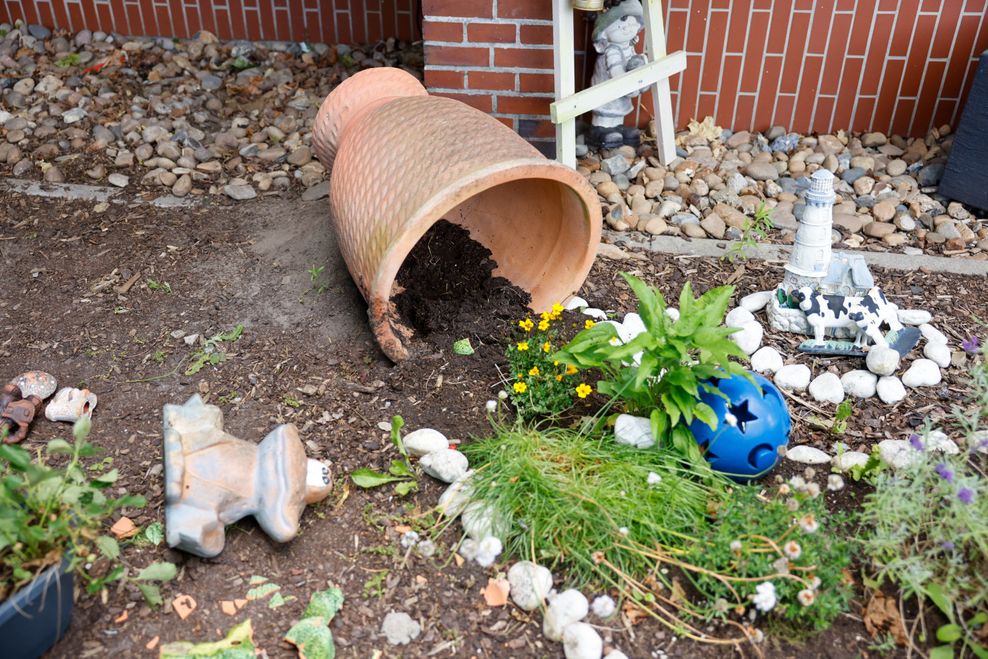The home-built vessel crafted by a blind man in Garden Grove was to sail from California to the Great Lakes, traveling more than 7,000 miles through open and inland waters.
Instead, the hull of the schooner named Visions sits landlocked amid a cluster of canyon oak trees, covered in dust, dry leaves and dead branches.
The original quest began miles from the ocean, as Don Baumea shaped the boat’s keel and watertight bottom by feel in his backyard. When he died, Robert Heerdt — an accountant turned fishing lake manager — bought the unfinished craft, vowing to complete the work and fulfill his predecessor’s dream of sailing it through the Panama Canal to the Great Lakes and beyond.
In April, however, Heerdt died without finishing the boat, leaving the watercraft marooned in the front yard of his Trabuco Canyon home. Now, Visions is awaiting its next adventurer willing to carry the dream forward.
“I don’t want to destroy it. I want it to live on,” said Tracey Marcyan, the real estate agent tasked with finding a new owner for the 50-foot-long, blue and white hull fashioned from fiberglass planks. “If someone were to take it, that would be a really happy ending for me … and (for) the family.”
To sell the property, Marcyan must dispose of boats, motor homes, rusting farm implements and a collection of personal treasures Heerdt, 89, left behind on his rambling 6-acre estate.
So, she’s offering the dry-docked craft to anyone willing to haul it away, perhaps to convert it into an Airbnb, perhaps to fulfill its destiny of sailing it around the world.
The story of Visions is just one more tale about a legion of aspiring mariners who build their “dream boats” in suburban backyards far from the ocean — with the majority of them failing to ever see water.
But it’s also a story about a poetry-loving adventurer who embraced Trabuco Canyon’s freethinking lifestyle in the mid-1960s and later ran the Oso Reservoir fishing club, which introduced thousands of youths to the sport.
His adventures included sailing another boat to Mexico, then up the East Coast to visit his son’s family in Maryland. He skied the Swiss Alps, floated down rivers in the Yukon and backpacked through the High Sierras in waist-deep snow, one son recalled.
He also was a member of the Vagabundos, a Baja California travel club, and was a regular at the Trabuco General Store’s Chicken Lips Coffee Club.
At home, he hunted ducks, rode motorcycles with his twin sons and steeped himself in cowboy culture, voraciously reading Western novels by authors like Louis L’Amour.
“He was … a cowboy-mariner. He loved adventure,” his son, Kevin Heerdt, 65, reminisced last week in the outdoor cantina his father built. “He thought he was invincible. … The world was his oyster.”
Seafaring dream
Heerdt’s seafaring dream began in the 1970s with Baumea, a boat builder and craftsman who lost his sight to diabetes. He didn’t let his disability stop him from building a boat in his backyard.
Using an intricate system of ropes, and aided by his wife, Baumea used the Lapstrake method to construct his hull, overlapping planks made from fiberglass instead of wood to create a watertight bottom.
He named his craft Visions.
“A person who is really blind is the one who doesn’t think,” the Los Angeles Times quoted Baumea as saying at the time.
But Baumea died in 1976 before he could finish his boat.
Kevin Heerdt thinks his father learned about Baumea’s story from the newspaper accounts at the time and decided to carry the dream forward. He paid $14,000 or $15,000 to buy the hull from Baumea’s widow in 1978.
Heerdt’s dream was even bigger than his Garden Grove peer. In addition to traveling through the Panama Canal to the Caribbean and then up to the Great Lakes, he fantasized about sailing up the Mississippi River, following Lewis and Clark, then crossing the Atlantic and sailing through the Dutch canals and on to the Mediterranean.
He moved Visions to a Costa Mesa boatyard and worked on it there. Kevin, attending USC at the time, would come down from college on weekends to help his dad work on the boat.
They installed bulkheads, a cabin and portions of the deck. He acquired a diesel engine, but “he never got the motor in,” Kevin Heerdt said.
Heerdt moved the boat to the front yard of his home about 15 to 20 years ago because he couldn’t afford to continue paying rent at the boat yard.
But progress was slow, his son said. The boat was one of many projects Heerdt had going on.
“My dad was the consummate dreamer,” he said. “He always had five or six projects. He’d work on it, (move on to something else), and come back to it.”
Kevin estimates his dad spent an additional $20,000 to $30,000 on the project. Meanwhile, it became something of a local landmark. Occasionally, Heerdt would find wedding parties sneaking onto his property to get pictures of the bride and groom next to the vessel.
“The longer it was here, the more of a fixture it became,” Kevin Heerdt said.
About 10 years ago, Heerdt’s plans for the boat changed from a seagoing vessel to converting it into a cabin or guest house. He failed to make that plan happen as well.
Backyard builders
Baumea and Heerdt were, by no means, alone. Newspaper stories abound of home-built boats over the past several decades.
In 1991, Leonard James hired a 150-ton crane to pluck a 45-foot, home-built boat from his backyard in Costa Mesa and onto a trailer. He’d been working on the “Connilen” for 20 years.
Six years later, Bill McPherson finished working on “Sweet Thang” after 5 ½ years, hiring a crane to move the 30-foot wooden trawler from his backyard in Anaheim and onto a truck.
In 2005, Tom Dale completed 26 years of work on his classic Galway Hooker, an Irish work boat, and had a crane move it from his backyard in Fullerton out to the street. Unfortunately, Dale crashed the boat onto a sandbar during its maiden voyage, demolishing a quarter-century of labor and dreams.
The boat’s name: “Astray.”
In 2014, Dillon Griffith was trying to come up with the money to move the “Mystic Rose,” another home-built craft, from his Sun Valley backyard to the water after working on it for 37 years.
“We have over a million (dollars) in that boat, and that’s without labor,” Griffith told the Los Angeles Daily News at the time.
What motivates such an obsession? Why do people build boats in their backyards?
“Usually, it’s the only way they could afford it,” said Jerry Wetzler of San Clemente, who built his own 40-foot catamaran in Newport Beach in the early 1970s. “Or they are craftsmen and, instead of a house, they want to build a boat.”
In 1972, Wetzler and a friend spent $248 to buy a set of plans from an Australian boat designer. They then spent $20,000 and the next four years building their craft on a vacant lot near the Mariner’s Mile in Newport Beach while living in a converted bread van.
“I was a fireman,” Wetzler said. “I didn’t have the money for a 40-foot sailboat.”
Forty-eight years later, the retired fire captain still is sailing that catamaran, named Freestyle, and has taken part in the Newport to Ensenada race 47 times.
During the 1960s and early 1970s, Costa Mesa was a hotbed of boat building, both for production boats and home-built boats, Wetzler said.
“Most boat builders at that time never finished their boats,” he said. “All these things came up, a change (in their) life. Things like losing your job or having a baby or all that. They didn’t realize how long it would take to build or finish a boat.”
These days, it’s unusual for people to build their own boats, said Jonathan Ide of Torrance, a semi-retired marine surveyor who conducts boat safety inspections in Redondo Beach and Long Beach.
“There are people who are inclined to do their own thing and will build their own boat,” he said. “But it’s very rare because the time and, of course, the money that you have to invest in it is significant.”
A lot of times, they never finish, Ide said.
“They either run out of time or run out of money. Or sometimes, I’ve had cases where the person’s health has deteriorated and they just can’t continue,” he said. In cases where the builder dies before finishing, the family “just wants to get rid of it.”
Sometimes, families are successful in selling those boats, Ide said. And “sometimes they end up in the scrapyard.”
Oso Bob
To many, Heerdt is known as “Oso Bob” because of the 15 years he spent running a fishing club at Upper Oso Reservoir, located east of Mission Viejo and about a 10-minute drive from his home. To qualify as members of the Heerdt’s Oso Sportsman Organization, anglers had to take five to 10 youths fishing each year.
Heerdt encouraged members to take inner-city kids and residents of the Joplin Boys Ranch, a nearby youth detention facility.
Many said Oso Bob had turned their lives around by teaching them to fish, Kevin Heerdt said.
Heerdt is survived by his twin sons and a daughter, eight grandchildren and six great-grandchildren.
His home goes on the market on June 21, listing agent Marcyan said.
The property consists of a 4.5-acre parcel listed for $2.05 million, and a separate 1.4-acre parcel listed for $400,000. In addition to the three-bedroom, 2 ½-bath house, the property includes several cabins.
Meanwhile, Marcyan said she’s gotten some nibbles from her offer to give Visions away. But nothing definite yet.
“We have it listed as, ‘Come take it for free,’ “ Marcyan said.
Kevin Heerdt said the hull definitely could be seaworthy, although he couldn’t guess how much it would cost to finish the boat.
“I would rather buy a boat” than finish building Visions, he said.
“But if you want to build a boat,” he added, “that’s a great way to start.”





